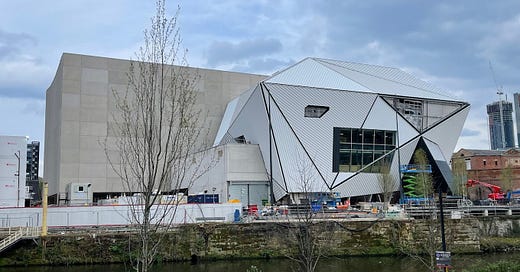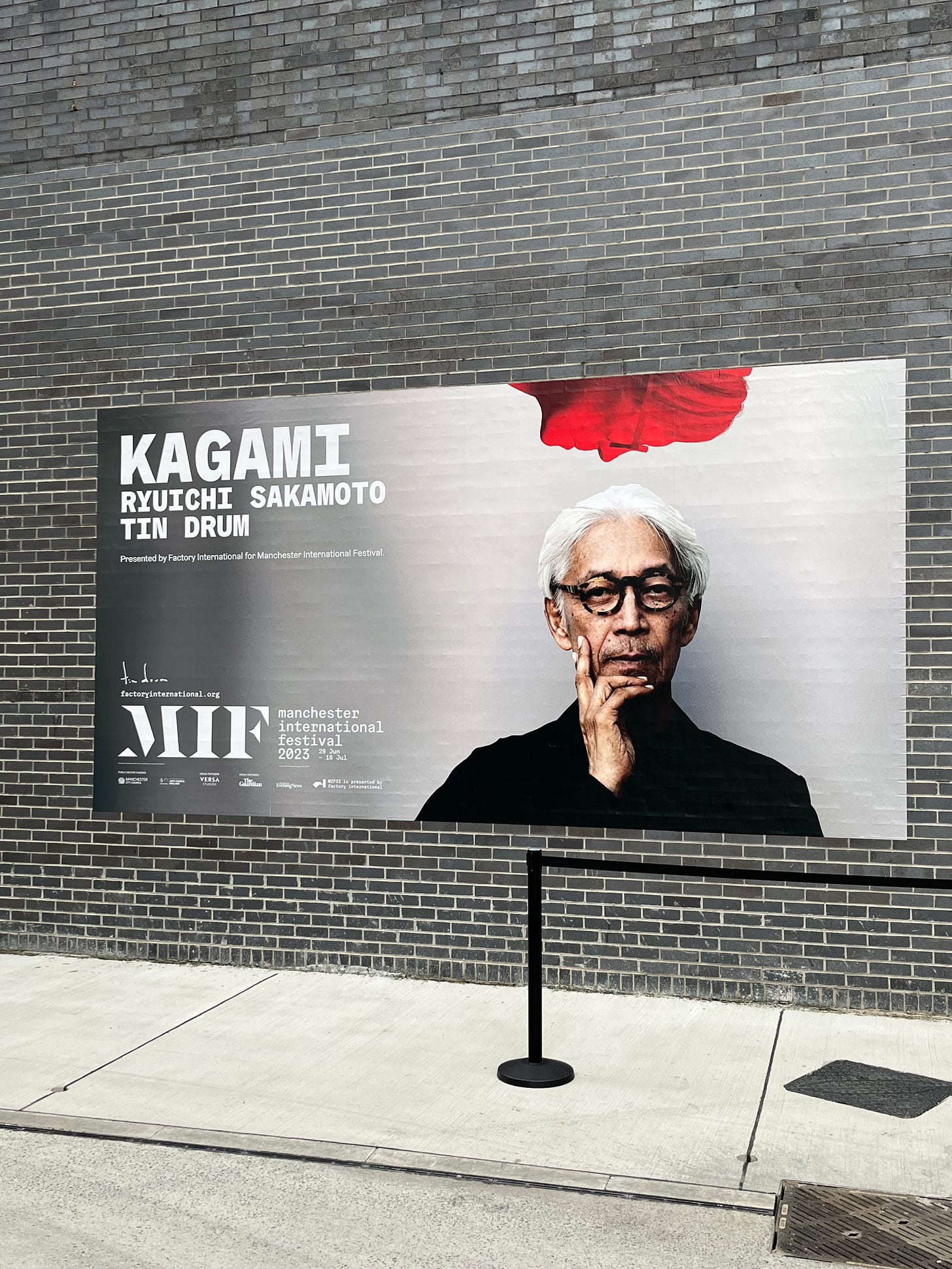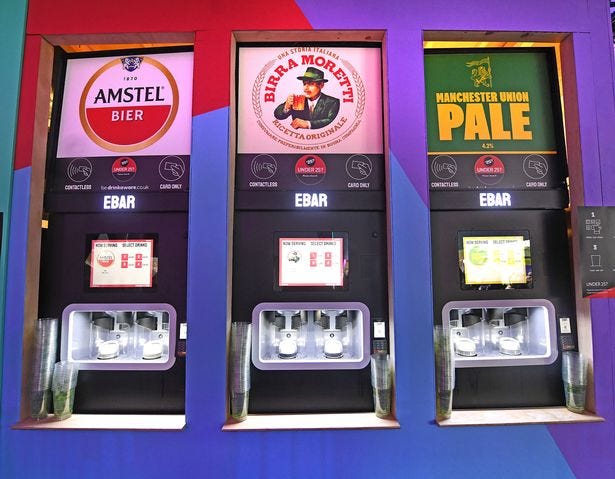Manchester's Insipid Festival
We went to see the glorious Ryuichi Sakamoto show and then got the sads
It’s edition 40 of Laughing Stock, making this our ruby newsletter. Rich Walker went to see Kagami, a gem of a show as part of Manchester International Festival, and then got massively dispirited about how safe the festival and its new home have become…
Home of Manchester International Festival (MIF), the Aviva Factory Booking.com News International Shell Arena is a soulless mess. I’m milling around, (well, trying to mill), the vast, expensive, ugly behemoth of a thing that has laboured its way into existence, 100% over budget and as yet unfinished, on the Manchester/Salford border on the River Irwell. It’s a clumsy brute of a building, even though it’s hard to get a grasp on what it actually looks or feels like due to it still essentially being a building site. This is what makes my milling about so uncomfortable. Everything feels like a chore, it’s hard to navigate, indeed it’s pretty hard to find if you are not familiar with this unloved and hugely redeveloped corner of town, there’s no sense of space or expansiveness that this project so openly craves, it just all feels…meh. It’s already badly designed in the public spaces - parking my bike was hampered by a clumsily placed concrete bench that prevented access to one side of the bike stand (it’s the little things, huh). It’s a far cry from what I would expect from an open, inviting, multicultural international arts venue.
There are loads of pieces on whether or not this building will achieve its aim of being a world renowned international destination for the arts (it being the largest publicly invested arts venture in the UK since Tate Modern opened in 2000, it better had be), whether it’s architecturally worthy or if the naming rights should have been given up to an insurance company not even linked with the city (in the way that say the Co-op is with it’s sponsorship of the new arena at the Etihad campus). Initial grumbles aside on the shitness of the building itself, that’s not the intention here, honest. The focus is on the insipid, uninspiring music programming of the 2023 edition of MIF.
I’m milling around the place because I bought a ticket to see Kagami (meaning ‘Mirror’), the collaboration between legendary Japanese composer Ryuichi Sakamoto and Tin Drum ‘the world’s premier studio producing content for mixed reality devices’. The piece was a shard of light in a sea of ‘so what’ when the MIF programme was announced, and I was thrilled that I could witness Sakamoto ‘in concert’, despite him not being present himself. Sakamoto never intended to be present for it. This is a virtual experience, one that immortalises Sakamoto’s piano playing in a 3D render seen through mad goggles worn throughout the concert. Alive when the programme was announced, he sadly passed away mere weeks before he got to see the collaboration come to fruition, lending the piece an inevitable, almost crushing sense of sadness and loss throughout.
I am directed to a different building at the side of the main Aviva Factory Unilever International PriceWaterhouseCoopers Stadium, the ‘Versa Manchester Studios’, as yet unsponsored, to see the show. A vast TV studio of a space, we’re ushered into an initial room through billowing white curtains to see a projection of Sakamoto recording field sounds in a forest and in what looks like the Arctic, surrounded by enormous images from his life. In the centre of the room is the modus operandi for the show from Sakamoto printed on the floor:
‘There is, in reality, a virtual me.
This virtual me will not age, and will continue to play the piano for years, decades, centuries.
Will there be humans then?
Will the squids that will conquer the earth after humanity listen to me?
What will pianos be to them?
What about music?
Will there be empathy there?
Empathy that spans hundreds of thousands of years.
Ah, but the batteries won’t last that long’
Reading this, surrounded by his image, is overwhelmingly moving. It’s hard to consider that he didn’t know the end of his life was imminent in reading those words, the final line a rumination not only on the longevity of this concert, but on his life too. I’m in pieces, and the thing hasn’t even started yet.
A vast door opens behind us, revealing an even bigger space featuring a single circle of chairs, a lighting rig, and a masking taped square on the floor in the centre of the room. Sitting down, I am presented with a pair of futuristic goggles that will enable me to experience a deceased man give a concert. I’m apprehensive when the intro voice over explains the technology and says something along the lines of ‘it may not be perfect but we’ve tried our best’, but that soon dissipates as Sakamoto appears dressed in black at a black grand Yamaha piano in front of my very eyes. It’s genuinely astonishing the level of detail that has been captured and rendered onto my retinas. His silver curtains sway as if on a breeze as he bobs his head along with his playing, he smiles, he looks pained, he looks deep in concentration. You can walk around the entire space to experience every angle of the projection - there’s no hiding place for the technology - and for the most part it absolutely holds up. Sure, it’s a bit uncanny valley at times, some of the surrounding projections of snow, or raindrops, or cityscapes are a bit cheesy (and perhaps unnecessary), sometimes his fingers look like they’re sinking into the piano keys, and there are a few jumpy glitches between songs as the image resets; however nothing can take away from the sheer weight of emotion that courses through me as I witness one of my most cherished musicians play from beyond the grave.
The music is, naturally, exquisite. For the most part very popularist, the set list could be an introduction to Sakamoto’s greatest hits from ‘Before Long’ to ‘Merry Christmas Mr. Lawrence’, all presented through his stately, masterful playing. The final track is introduced by Sakamoto himself, his voice appearing out of the ether, to tell us it’s a short track he wrote five minutes after hearing about the death of his friend, the director Bernardo Bertolucci. It’s an impossibly moving ending to an impossibly moving concert. As I wander back to my seat to return the goggles, a woman next to me removes hers too and sobs into her partner’s shoulder. It’s that kind of experience.
Like I said, a genuinely groundbreaking shard of light in an otherwise completely uninspiring musical programme at MIF - even this isn’t exclusive - it’s being presented in New York at the same time. The problem with MIF is that it’s so damn safe in its musical choices, when this is a programme that is widely marketed and projected internationally as a pioneering festival. There is zero edge. It is a middle of the road, mid-range programme for middle class, middle aged people (I’m well aware that myself, going to a virtual reality experience of an acclaimed Japanese composer, fit squarely in this bracket), and it’s kind of embarrassing when you look at the embarrassment of riches on offer from genuinely boundary pushing musicians across the region.
On the paid concert side Janelle Monae was MIFs big bet, despite having played the festival’s last full edition in 2019; however, they pulled out so it didn’t even happen. There’s John Grant and Richard Hawley playing the songs of Patsy Cline; new-jazz poster boys The Comet is Coming; Alison Goldfrapp doing solo material; Anna Meredith presenting an album 4 years old; Ben UFO (an LS fav, make no mistakes) and his affluent mates putting on contemporary dance for the masses so they get to experience it. Amongst those, not a single artist from the North West, nevermind Greater Manchester. I’m not advocating that at an ‘International festival’ the programming should be made up completely of local talent; that said surely some of it should be, and this should be presented to an international audience as the best of the creative industry the area has to offer. Maybe pair local talent with international talent to create something new and exciting?
Most of the local artists are squirrelled away in the free programming of Festival Square. Once an open and easily accessible hub for the festival outside the town hall in the centre of Manchester where passing footfall meant people who might not interact with the main festival programming could get a taste of what MIF has on offer, it’s now hidden away from anyone who isn’t purposefully visiting the Factory site underneath a vast concrete canopy. Clutching a £6 a pint served from a robot vendor, you can watch generic Manchester house bands such as A Certain Ratio, The Orielles, Dutch Uncles and more, acts who regularly play venues across town and present a very certain traditional sound of the city. To be fair, there’s some slightly more exciting stuff, for example a night curated by the brilliant Chunky, and TransCreative presenting a night of ‘trans excellence’ on another, but aside from these the programme is bland. In other areas they appear to get things completely wrong despite good intentions. On a night that presents itself to ‘disrupt the male-dominated music industry with this genre-hopping celebration of women, non-binary and queer talent’ I shit you not those genuinely interesting artists are billed as ‘Dave Haslam presents…’ ffs.
Some might say a free showcase of local artists is a good thing, giving them a larger platform and exposing them to a crowd who might not be willing to pay to see them. I would say it undervalues their talent. One look around Festival Square confirms to me that this programme isn’t attracting many new faces to the area; it’s still the same middle class, middle aged, predominately white crowd who are paying for the concert tickets and then nipping through to festival square for a post culture wind down with a £7.50 glass of Sauv Blanc. If MIF is to serve everyone in Greater Manchester, then it needs to pull down its safety bumpers and let in a little danger. Where’s the drill night in the main space, celebrating the vibrant scene that’s torn up the town? Where are the Greater Manchester based cutting edge electronic artists who thrive in the darkest recesses of the city to much acclaim, presenting their shows and premieres across Europe? Where’s the Youth or Sferic or Boomkat or NTS or Meat Free or Fat Out nights? Where’s the original musical commissions from some of the region’s avant garde composers? Where’s a homecoming for some of the big breakthrough artists like Aitch or Bugzy Malone instead of the Janelle Monaes of this world?
Or maybe MIF isn’t for this kind of thing. Maybe MIF should be a safe space for the middle classes, to whom this programme might represent the cutting edge of music culture? Perhaps this stuff should be left to another festival, Greater Manchester’s own Unsound, Atonal, C2C or Rewire, one that could showcase to the world just how exciting music from this city truly is. One can only hope one emerges.
If you have enjoyed this #content and would like to subscribe to this irregular newsletter, then do so below. We also put our favourite songs in a rolling 2023 playlist, listen via Apple or Spotify. Follow our Instagram and Twitter for highly engaging content. Wout van Aert is a mad machine of a man. Maximum respect.







Those “genuinely interesting artists” - the Red Stains and Heartworms - were so brilliant when they played. They were chosen by me. I originated the event. Which is why it was billed as “Dave Haslam presents”. I shit you not.